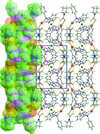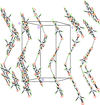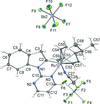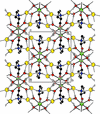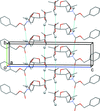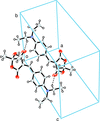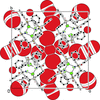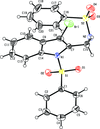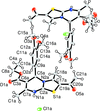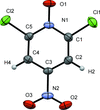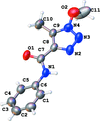issue contents
October 2015 issue

Cover illustration: The tetrapeptide Boc-(S)-ABOC-(S)-Ala-(S)-ABOC-(S)-Phe-OBn contains two non-proteinogenic amino acid residues [(S)-ABOC], two amino acid residues [(S)-Ala and (S)-Phe], and the protecting groups Boc and OBn. It folds into a right-handed mixed 11/9 helix stabilized by intramolecular i,i + 3 and i,i-1 C=O H-N hydrogen bonds. The oligomers are linked into chains by N-H
H-N hydrogen bonds. The oligomers are linked into chains by N-H O=C hydrogen bonds with the chloroform solvent molecules intercalated between the folded chains via C-H
O=C hydrogen bonds with the chloroform solvent molecules intercalated between the folded chains via C-H O=C interactions. See: Wenger, Moulat, Legrand, Amblard, Calmès & Didierjean [Acta Cryst. (2015). E71, 1193-1195].
O=C interactions. See: Wenger, Moulat, Legrand, Amblard, Calmès & Didierjean [Acta Cryst. (2015). E71, 1193-1195].
research communications
Download citation


Download citation


The title compounds consist of a 1,7,7-trimethylbicyclo[2.2.1]heptane (bornane or camphane) skeleton which is decorated with acetamide for (±)-(1) and chloroacetamide for (±)-(2), functionalities. In the crystals of both compounds, molecules are linked via N—H⋯O hydrogen bonds, reinforced by C—H⋯O contacts, forming chains propagating along the a axis.
Download citation


Download citation


A second polymorph (monoclinic with Z′ = 1) of the title compound is reported in which the conformation resembles one of the independent molecules of the original triclinic polymorph (Z′ = 2).
CCDC reference: 1420783
Download citation


Download citation


The isostructural 1-bromo and 1-iodo derivatives of 3,5-bis(1,3-oxazolin-2-yl)benzene show supramolecular features of (non-classical) hydrogen bonding, parallel-displaced π–π interactions, and close N⋯I contacts. The former was found to crystallize as a sub-hydrate.
Download citation


Download citation


The crystal structures of the two title compounds display chair conformations of the piperidine rings in their molecules. In compound (I), the biphenyl system has a twisted conformation with a dihedral angle of 26.57 (6)° while in compound (II) the two phenyl rings are exactly coplanar.
Download citation


Download citation


The title Schiff base, 2-methylsulfanyl-N-[(1H-pyrrol-2-yl)methylidene]aniline, crystallizes in the presence of a methanol molecule and features three distinct hydrogen bonds to each heteroatom in the molecule. The crystal lattice exhibits an array of methanol molecules sandwiched between the title compound exhibiting weak supramolecular interactions.
CCDC reference: 1417853
Download citation


Download citation


In the title compound, the two indole ring systems are approximately perpendicular to one another, with a dihedral angle between their planes of 84.0 (5)°.
CCDC reference: 1421585
Download citation


Download citation


The centrosymmetric molecule features a linearly coordinated AuI atom within an S(dithiocarbamate) and P(phosphane) donor set.
CCDC reference: 1421954
Download citation


Download citation


The crystal structures of the two title compounds each display the chair conformation of their piperidine rings. In 4,4′-bis[3-(pyrrolidin-1-yl)prop-1-yn-1-yl]-1,1′-biphenyl, the biphenyl rings are coplanar because the molecules sit on crystallographic centres of inversion. In 4,4′-bis{3-[(S)-2-methylpyrrolidin-1-yl]prop-1-yn-1-yl}-1,1′-biphenyl, the biphenyl ring system has a twisted conformation with a dihedral angle of 28.76 (11)°.
Download citation


Download citation


In the crystal of the title compound, molecules are linked via O—H⋯O and C—H⋯O hydrogen bonds, forming undulating sheets parallel to (10 ). The sheets are linked via C—H⋯π and offset face-to-face π-interactions, between inversion-related molecules [inter-centroid distance = 3.7843 (16) Å], forming a three-dimensional structure.
). The sheets are linked via C—H⋯π and offset face-to-face π-interactions, between inversion-related molecules [inter-centroid distance = 3.7843 (16) Å], forming a three-dimensional structure.
CCDC reference: 1416885
Download citation


Download citation


The redetermination of the structure of the title compound with the original measurement data revealed a centrosymmetric model in space group Pmcn, in contrast to the previous model in space group P21cn.
CCDC reference: 1423010
Download citation


Download citation


The five-membered 1,2,4-dithiazole rings in the cations of (I) and (II) are almost planar, but in each case the overall cation is twisted with dihedral angles between the planes of the heterocycle and the pendant aryl ring of 9.05 (12) and 15.60 (12)° in (I) and (II), respectively. In both compounds, the bond lengths in the H2N—C—N—C—N backbones imply considerable delocalization of π-electron density.
Download citation


Download citation


The mononuclear complex [Fe(acac)2(OTf)(THF)] (acac = acetylacetonate; OTf = trifluoromethanesulfonate) consists of a mononuclear six-coordinate Fe3+ center in a slightly distorted octahedral environment and is only the second crystal structure reported of a mononuclear bis(acetylacetonato)iron(III) complex.
CCDC reference: 1423096
Download citation


Download citation


The present paper reports crystallographic studies on three related compounds that were of interest as precursors for synthetic and mechanistic work in organosulfur chemistry, as well as to model nitrogen-protecting groups.
Download citation


Download citation


The two RuII cations, each with the characteristic piano-stool coordination geometry, are bridged by three thiolate ligands. The resulting dinuclear complex cation exhibits point group symmetry 1.
CCDC reference: 1423473
Download citation


Download citation


The two compounds are isotypic and the two-dimensional polymeric structure is based on centrosymmetric dinuclear bridged complex units. Within the layers, which lie parallel to (100), the coordinating water molecule forms an O—H⋯O hydrogen bond to the single bridging carboxylate O atom.
Download citation


Download citation


In the title compound, the dioxolane and cyclohexane rings adopt twist and chair conformations, respectively. In the crystal, intra- and intermolecular O—H⋯O hydrogen bonds are observed.
CCDC reference: 1422946
Download citation


Download citation


In the title complex, the CoII cation has a distorted square-pyramidal coordination environment, being coordinated by four N atoms of four imidazole groups in the basal plane and by a Cl atom in the apical position. In the crystal, the [CoCl(C3H4N2)4]+ cations and chloride Cl− anions are linked via N—H⋯Cl hydrogen bonds, forming layers parallel to (010).
CCDC reference: 1420121
Download citation


Download citation


Cyclometalated Ru complexes play a major role in catalytic transformation. The Ru cation is coordinated by a pyrimidyl-3H-indole ligand, as well as a para-cymene ligand and one acetonitrile molecule.
CCDC reference: 1027878
Download citation


Download citation


In the title compound, the α,β-hybrid peptide contains two non-proteinogenic amino acid residues [(S)-ABOC], two amino acid residues [(S)-Ala and (S)-Phe], and protecting groups of Boc and OBn. The tetramer folds into a right-handed mixed 11/9 helix stabilized by intramolecular i,i + 3 and i,i-1 C=O⋯H—N hydrogen bonds. The oligomers are linked into chains by N—H⋯O=C hydrogen bonds with the chloroform solvent molecules intercalated between the folded chains via C—H⋯O=C interactions.
CCDC reference: 1423394
Download citation


Download citation


In the crystal of the title molecular salt, the 3-methylpyridinium cation and the picrate anion are linked via bifurcated N—H⋯(O,O) hydrogen bonds, forming an  (6) ring motif. These units are linked via C—H⋯O hydrogen bonds, forming a three-dimensional framework·The compound exhibits anticonvulsant activity.
(6) ring motif. These units are linked via C—H⋯O hydrogen bonds, forming a three-dimensional framework·The compound exhibits anticonvulsant activity.
CCDC reference: 1417794
Download citation


Download citation


In the title polymer, zwitterionic proline and water molecules interact with the bromide counter-anions through intermolecular N—H⋯Br and O—H⋯Br hydrogen-bonding interactions, providing a novel supramolecular structure.
CCDC reference: 1424731
Download citation


Download citation


Using a predesigned Schiff base tripodal ligand, a cubane-type tetranuclear copper(II) cluster has been synthesized and its structure redetermined at 200 K.
CCDC reference: 1424781
Download citation


Download citation


The conformation of the piperidine ring is modified by the hybridization state of the C atom in the α-position to the piperidinic N atom.
Download citation


Download citation


The title compound consists of a substituted 2,2-dimethyltetrahydrofuro[2,3-d][1,3]dioxolane skeleton. The furanose ring adopts a conformation close to C3-exo. Both dioxolane rings adopt envelope conformations with an O atom as the flap in each case. In the crystal, molecules are linked by N—H⋯O hydrogen bonds, forming chains propagating along the b-axis direction.
CCDC reference: 1425954
Download citation


Download citation


In the title complex, the two symmetry-related RuII atoms are bridged by two 4-methoxy-α-toluenethiolate [(4-methoxyphenyl)methanethiolate] units. One chloride ligand and the p-cymene ligand complete the typical piano-stool coordination environment of the RuII atom. In the crystal, the CH moiety of the chloroform molecule interacts with the chloride ligand of the dinuclear complex, while one Cl atom of the solvent interacts more weakly with the methyl group of the bridging 4-methoxy-α-toluenethiolate unit. This assembly leads to the formation of supramolecular chains extending parallel to [021].
CCDC reference: 1415346
Download citation


Download citation


A binuclear bis(carboxylato)dirhenium(III) complex is reported. The compound is a representative of a small class of alkylcarboxylate complexes involving a quadruple metal–metal bonds
CCDC reference: 1425634
Download citation


Download citation


The title aluminium complex was prepared by methane elimination from the reaction of 2-(diethylaminomethyl)indole and trimethylaluminium. Each of the two crystallographically independent molecules has a four-coordinate aluminium center that has pseudo-tetrahedral geometry.
CCDC reference: 1423793
Download citation


Download citation


Crystal structures of morpholinium hydrogen bromanilate have been determined at 130, 145 and 180 K. The asymmetric unit comprises one morpholinium cation and two halves of crystallographically independent bromanilate monoanions. The conformations of the two independent bromanilate anions are different from each other with respect to the O—H orientation. The two different anions are linked alternately into a chain though a short O—H⋯O hydrogen bond, in which the H atom is disordered over two positions.
Download citation


Download citation


In the crystals of the title N-halomethylated quaternary ammonium salts, there are short I⋯I− interactions of 3.564 (4), 3.506 (1) and 3.55781) Å for compounds (I), (II) and (III), respectively. In (I), molecules are linked by C—H⋯I− and C—H⋯π interactions, together with the I⋯I− short contacts, forming ribbons along [100]. In (II), there are only C—H⋯I− interactions, which together with the I⋯I− short contacts, lead to the formation of helices along [010]. In (III), apart from the I⋯I− short contacts, there are no other significant intermolecular interactions present.
Download citation


Download citation


The title twisted thiosemicarbazone molecule has, respectively, anti- and syn-dispositions of the p-tolyl-N—H and imino-N—H groups with respect to the central thione-S atom allowing for the formation of an intramolecular p-tolyl-N—H⋯N(imino) hydrogen bond. The presence of N—H⋯S hydrogen bonds lead to layers in the bc plane which are connected by methyl-C—H⋯π interactions.
CCDC reference: 1425975
Download citation


Download citation


The title compound, 5-[4-(diethylamino)phenylmethylidene]-2,2-dimethyl-1,3-dioxane-4,6-dione, have been synthesized and its crystal structure determined. Due to the absence of hydrogen-bond donors in the structure, the crystal packing is controlled by van der Waals forces and weak C—H⋯O interactions, which associate the molecules in dimers.
CCDC reference: 1426237
Download citation


Download citation


The title compound, consisting of a terpyridine group linked to a N-oxylpyrroline-3-formate group by a phenylethynylbiphenyl spacer, crystallized as a benzene two and a half solvate. Its structure is compared to that of the same molecule that crystallized as a dichloromethane solvate and to a similar molecule with a shorter spacer unit viz. ethynylphenyl.
CCDC reference: 1426093
Download citation


Download citation


The title double salt containing two distinct, differently protonated hexamolybdoplatinate(IV) polyanions. The polyanion pairs both form dimers of the same formula, viz. {[H10α-Pt2Mo12O48]}6− connected by seven interpolyanion O—H⋯O hydrogen bonds.
CCDC reference: 1426214
Download citation


Download citation


The transition metal orthophosphates SrM2Fe(PO4)3 (M = Co, Ni) crystallize in an α-CrPO4-type structure. The chains characterizing this structure are then built up from [Ni2O10] units alternating with [PO4] tetrahedra and [FeO6] octahedra. The structure is nearly the same as that observed in MMnII2MnIII(PO4)3 (M = Pb, Sr, Ba).
CCDC reference: 1426730
Download citation


Download citation


Crystal structure of [5-bromo-2-(pyridin-2-yl-κN)phenyl-κC1](pentane-2,4-dionato-κ2O,O′)platinum(II)
In the title complex, [Pt(C11H7BrN)(C5H7O2)], two crystallographically non-equivalent dimers stacked by π–π interactions are arranged antiparallel to each other.
CCDC reference: 1425736
Download citation


Download citation


In the title compound a distorted Ag4N4-heterocubane core is set up by AgI cations and N atoms of cyanate anions. The core is decorated by four triphenylphosphine ligands bonded to the AgI cations. Ag⋯Ag distances as short as 3.133 (9) Å suggest the presence of argentophilic (d10⋯d10) interactions.
CCDC reference: 1426238
Download citation


Download citation


In view of its potential for developing useful pharamaceutical formulations of furosemide, a widely-used loop diuretic, the crystal structure of the furosemide anion with m-chlorobenzoate has been investigated. In these co-crystals, the monoanions of furosemide and m-chlorobenzoate are balanced by two independent Na+ ions, both of which are hexacoordinated by three monodentate water molecules, two double-water bridge molecules and one single-water bridge molecules, thus yielding centrosymmetric Na2(OH2)8 units linked by single water bridges to form chains in the [ 10] direction.
10] direction.
CCDC reference: 1425658
data reports
inorganic compounds
Download citation


Download citation


metal-organic compounds
Download citation


Download citation


Download citation


Download citation


Download citation


Download citation


Download citation


Download citation


Download citation


Download citation


organic compounds
Download citation


Download citation


Download citation


Download citation


Download citation


Download citation


Download citation


Download citation


Download citation


Download citation


Download citation


Download citation


Download citation


Download citation


Download citation


Download citation


Download citation


Download citation


Download citation


Download citation


Download citation


Download citation


Download citation


Download citation


Download citation


Download citation


Download citation


Download citation


Download citation


Download citation


Download citation


Download citation


Download citation


Download citation


Download citation


Download citation


Download citation


Download citation


Download citation


Download citation


Download citation


Download citation


Download citation


Download citation


Download citation


Download citation


Download citation


Download citation


Download citation


Download citation


Download citation


Download citation


Download citation


Download citation


Download citation


Download citation


Download citation


Download citation


Download citation


Download citation


Download citation


Download citation


Download citation


Download citation


Download citation


Download citation


Download citation


Download citation


Download citation


Download citation


Download citation


Download citation


Download citation


Download citation


Download citation


Download citation


Download citation


Download citation


Download citation


Download citation


Download citation


Download citation


Download citation


Download citation


Download citation


Download citation


Download citation


Download citation


Download citation


Download citation


Download citation


Download citation


Download citation


Download citation


Download citation


Download citation


Download citation


Download citation


Download citation


Download citation


Download citation


Download citation


Download citation


Download citation


Download citation


Download citation


Download citation


Download citation


Download citation


Download citation


Download citation


Download citation


Download citation


Download citation


Download citation


Download citation


Download citation


Download citation


Download citation


Download citation


Download citation


Download citation




 journal menu
journal menu

















